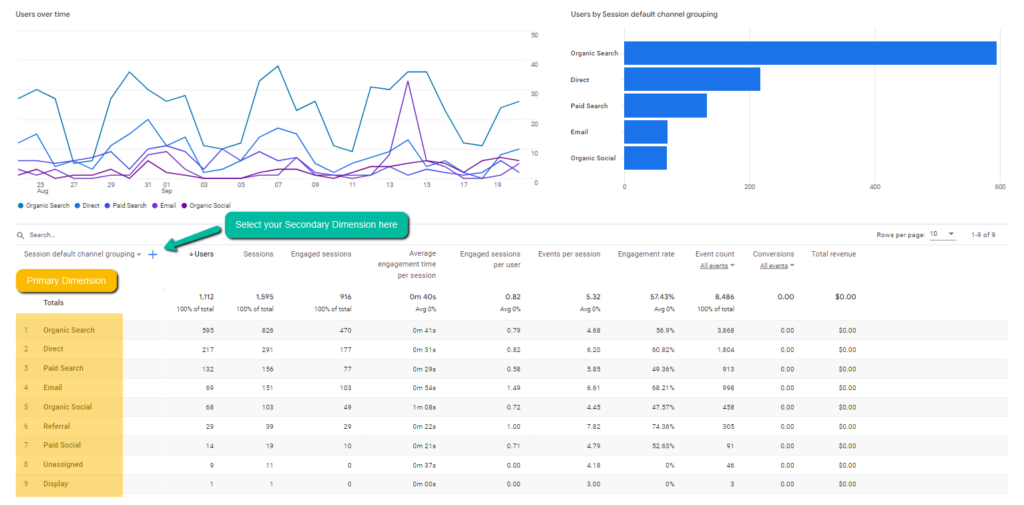Google Analytics Mastery: Revealing the Possible of Secondary Dimension
Google Analytics Mastery: Revealing the Possible of Secondary Dimension
Blog Article
Opening the Power of Additional Measurement Analytics for Boosted Data Insights and Decision-Making
In the realm of data analytics, key measurements frequently take the spotlight, yet the true deepness of insights lies within the realm of secondary dimensions. By using the power of secondary measurement analytics, organizations can introduce hidden fads, uncover connections, and remove much more purposeful final thoughts from their data.
Significance of Secondary Measurements
Discovering the relevance of secondary measurements in analytics reveals the surprise layers of data understandings important for notified decision-making in different domains. Additional dimensions offer a deeper understanding of primary data by offering extra context and viewpoints. By integrating secondary measurements into analytics, companies can draw out more nuanced and comprehensive insights from their datasets.
One trick importance of additional measurements is their ability to segment and categorize main data, permitting an extra detailed analysis of specific subsets within a dataset. This division enables businesses to identify patterns, trends, and outliers that may not appear when considering the information overall. Moreover, secondary dimensions aid in discovering relationships and dependences between various variables, resulting in even more accurate forecasting and anticipating modeling.
Furthermore, second dimensions play a crucial function in improving data visualization and coverage. By adding additional dimensions to visualizations, such as graphs or charts, analysts can produce extra useful and informative representations of data, promoting much better interaction of searchings for to stakeholders. Generally, the assimilation of second dimensions in analytics is important in unlocking the full capacity of information and driving evidence-based decision-making.
Key Benefits of Using Additional Measurements
Making use of additional measurements in analytics provides organizations a calculated advantage by enhancing the deepness and granularity of data insights. One crucial benefit of incorporating second dimensions is the capacity to segment and filter information, permitting a more detailed evaluation of specific facets within a dataset. This segmentation enables organizations to get an extra nuanced understanding of their audience, performance metrics, and various other essential data factors. By dissecting data making use of secondary measurements such as time, location, tool type, or user demographics, organizations can uncover patterns, trends, and connections that may or else continue to be concealed.
Moreover, the utilization of second dimensions enhances the context in which primary information is interpreted. By leveraging second dimensions in analytics, companies can harness the full possibility of their data to drive better decision-making and accomplish their company objectives.
Advanced Data Analysis Techniques
A deep study advanced information evaluation strategies discloses innovative methods for extracting valuable understandings from intricate datasets. One such technique is device learning, where formulas are employed to identify patterns within data, anticipate results, and make data-driven choices. This approach allows for the automation of analytical model building, making it possible for the processing of large volumes of data at a much faster rate than traditional methods.
One more sophisticated strategy is predictive analytics, which uses analytical algorithms and device discovering strategies to anticipate future results based upon historical information. By evaluating fads and patterns, businesses can anticipate customer behavior, market patterns, and prospective threats, equipping them to make aggressive choices.
Additionally, text mining and view evaluation are important techniques for removing understandings from disorganized data resources such as social media sites comments, customer evaluations, and study actions. By examining message information, organizations can comprehend customer point of views, identify arising trends, and improve their product and services based on responses.
Enhancing Decision-Making Through Second Measurements

Enhancing decision-making via secondary measurements makes it possible for organizations to make even more notified and targeted calculated options. By segmenting client information based on secondary dimensions like purchasing background or involvement degrees, firms can tailor their advertising and marketing approaches to click site specific target market segments, leading to boosted conversion rates and customer contentment. Furthermore, secondary dimensions can aid recognize correlations and partnerships between various variables, making it possible for organizations to make data-driven choices that drive development and profitability.
Implementing Second Dimension Analytics
When including additional dimensions in analytics, organizations can unlock much deeper insights that drive calculated decision-making and boost general performance. This entails recognizing the specific inquiries the company seeks to answer and the information points called for to address them.

In addition, companies need to utilize progressed analytics tools and technologies to streamline the process of including additional measurements. These tools can automate data handling, analysis, and visualization, allowing companies to concentrate on translating understandings instead of manual information manipulation.
Final Thought
Finally, additional measurement analytics play a crucial duty in enhancing information insights and decision-making processes. By utilizing sophisticated information evaluation methods and carrying out second dimensions efficiently, companies can unlock the power of their data to drive tactical organization decisions. The key benefits of news using additional measurements can not be overstated, as they provide a deeper understanding of information patterns and partnerships. It is necessary for organizations to leverage additional dimension analytics to remain affordable in today's data-driven landscape.
In the realm of information analytics, key measurements often take the limelight, but the real deepness of insights lies within the realm of secondary dimensions.Making use of secondary dimensions in analytics supplies companies a critical advantage by augmenting the deepness and granularity of data insights. By leveraging second dimensions in analytics, organizations can harness the full capacity of their data to drive better decision-making and accomplish their business goals.
Applying data validation procedures and regular audits can assist preserve information quality and reliability.
By making use of innovative data evaluation techniques and executing secondary dimensions properly, organizations can unlock the power of their data to drive strategic service decisions.
Report this page